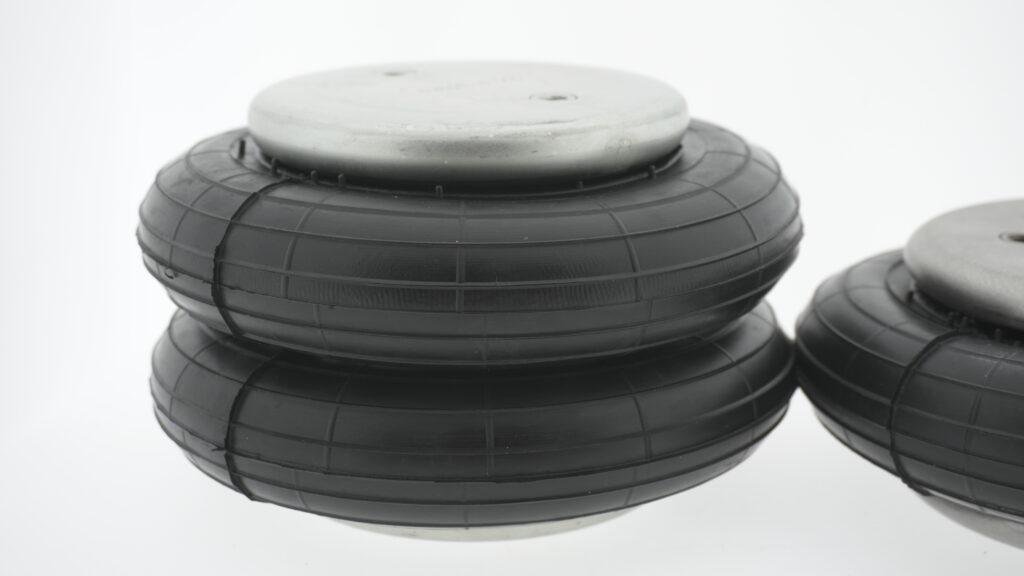
Understanding the Impact of Extreme Environments on Air Bellows
Air bellows play a crucial role in industrial applications, providing flexible support, vibration isolation, and controlled motion. However, their performance and longevity can be significantly affected in extreme environments. Understanding environmental stressors ensures optimal operation and prevents premature failure. Key factors include temperature variations, pressure fluctuations, chemical exposure, and mechanical stress.
Technical data confirms that standard air bellows operate at 8 to 12 bar, depending on reinforcement layers and material composition. Four-ply models support higher pressures, making them ideal for intensive applications.
Choosing the correct material composition and reinforcement structure helps withstand extreme operational conditions. Proper selection ensures that air bellows maintain structural integrity, efficiency, and safety in high-load or chemically aggressive environments. Without appropriate material selection, premature cracking, hardening, and failure may occur, compromising system efficiency and increasing maintenance costs.

Material Selection for Enhanced Durability
Material selection directly impacts air bellows’ durability and resistance to temperature fluctuations, chemical exposure, and mechanical wear. Natural rubber (NR/SBR) is widely used due to its high dynamic capability, while nitrile rubber (NBR) provides superior oil and fuel resistance. EPDM offers excellent ozone and weather resistance, making it ideal for outdoor applications.
Air bellows featuring stainless steel reinforcement (AISI-304 or AISI-316L) offer improved resistance to oxidation, corrosion, and chemical deterioration. These materials ensure a longer service life in highly corrosive or humid environments.
Rubber compounds should match operating conditions, including pressure load, environmental exposure, and dynamic performance needs. Reinforced fiber layers increase mechanical stability, minimizing elongation and deformation over time. Selecting proper materials prevents cracking, material hardening, and premature failure, ensuring consistent performance and extending product lifespan.
Temperature Extremes: Managing Thermal Stress
Air bellows must withstand high and low temperatures while maintaining structural integrity. Standard air bellows operate between -40°C and +70°C, but specialized compounds extend this range up to +115°C. Poor thermal resistance leads to hardening, cracking, or softening, reducing efficiency and increasing failure risk.
For extreme heat, high-temperature rubber compounds like chlorobutyl (CIIR) or EPDM improve thermal resistance. In low temperatures, maintaining flexibility is necessary to prevent rigidity and function loss.
Rubber elasticity ensures uniform load distribution and structural flexibility, crucial in temperature-variable settings. Applications exposed to sudden temperature shifts require elastomers with enhanced thermal stability to avoid material fatigue.
Proper storage and maintenance extend service life, as rubber degradation accelerates under UV radiation or ozone exposure. Protecting air bellows from these elements maintains optimal performance and long-term durability.
Pressure Considerations in High-Stress Environments
Standard air bellows operate at a maximum pressure of 8 bar, but reinforced models withstand up to 12 bar. Exceeding pressure limits may cause deformation, rupture, or leaks, reducing safety and efficiency. Routine pressure monitoring and system optimization help maintain structural reliability.
Four-ply air bellows provide additional reinforcement, enabling higher pressure tolerance. Extra reinforcement layers minimize elongation, ensuring load stability under extreme pressure.
Fluctuating pressure can cause stress concentration and weakening. Installing pressure relief systems and reinforced air supply connections prevents damage.
Correct installation, alignment, and mounting design distribute pressure evenly, enhancing longevity. Regular inspections detect early-stage damage, preventing catastrophic failures. By ensuring proper installation, inspection, and reinforcement, industries can optimize air bellows’ performance and lifespan.
Chemical and Corrosive Exposure: Ensuring Resistance
Industrial chemicals, oils, and solvents degrade rubber compounds and metal components. Stainless steel end fittings, such as AISI-304 and AISI-316L, provide corrosion resistance, while chlorobutyl (CIIR) compounds enhance acid resistance.
In aggressive environments, proper elastomer selection is vital. NR/SBR rubber compounds degrade in prolonged oil or solvent exposure, whereas NBR and EPDM offer superior chemical resistance.
For high-humidity conditions, water-resistant materials like specialized rubber coatings and anodized aluminum components enhance longevity. Protective coatings prevent chemical permeation, minimizing wear and extending lifespan.
Routine elastomer inspections, end fitting evaluations, and corrosion checks ensure continuous safe operation. Without adequate chemical protection, degradation accelerates, increasing replacement costs and system downtime.
Vibration and Shock Absorption in Harsh Conditions
Air bellows provide exceptional vibration isolation and shock absorption, ensuring smooth operation in high-dynamic industrial settings. With a vibration isolation efficiency of over 99%, they protect sensitive machinery and equipment from structural fatigue.
Technical tests show that correct air pressure and mounting configurations enhance vibration absorption. Low-frequency applications require air bellows with optimized damping properties to minimize mechanical stress.
Using customized mounting brackets and reinforced elastomers improves shock absorption efficiency. Proper airflow regulation prevents overpressure shocks, reducing component damage.
Well-designed reinforced bead plates enhance impact resistance, decreasing failure risk in extreme vibration environments. Ensuring correct system integration maximizes durability and performance in high-vibration conditions.
Preventing Fatigue and Mechanical Wear
Continuous flexing and load changes accelerate material fatigue, reducing air bellows’ service life. Proper installation, alignment, and maintenance prevent mechanical stress, ensuring reliability in high-cycle applications.
High-tensile-strength rubber compounds extend durability in frequent movement cycles. Stress analysis confirms that reinforced fiber layers reduce localized wear, preventing early failure.
Periodic air loss rate monitoring, mounting inspections, and deformation checks enhance longevity. Lubricated sealing interfaces reduce friction, minimizing material degradation.
Proper handling and controlled storage prevent early wear, ensuring consistent reliability in demanding industrial conditions. Adopting preventive maintenance strategies minimizes downtime and extends operational life.
Ensuring safe and effective air bellows operation in extreme environments requires careful material selection, pressure control, chemical resistance, vibration management, and preventive maintenance. By applying proper safeguards and inspections, industries maximize efficiency, safety, and longevity in demanding applications.
